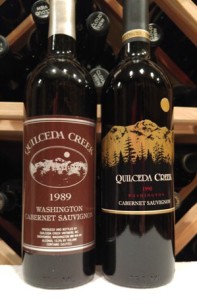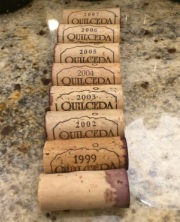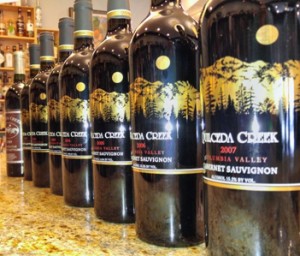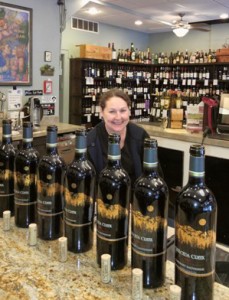In the mid-1990s I was first introduced to the wines of Quilceda Creek, one of the early producers in Washington’s Columbia Valley. Julie was representing a client in a case in Seattle and she brought home a bottle. We just did not understand what we had. A year or two later, our friend Steve Hamm, a wine professional for 35+ years who I have mentioned in previous articles, hosted a ten-vintage vertical tasting of Quilceda Creek.
None of us who were there, including Steve, can put a finger on exactly when the tasting was or which vintages were involved. But we can all agree that we were blown away by this producer of Cabernet Sauvignon that most of us had barely heard of before, and that there were several vintages with the old Quilceda Creek label, and many with the new.
Quilceda Creek is not what most people would think of as an everyday wine. The 2005 vintage was served by the White House at a state dinner for then-Chinese president Hu Jintao in 2011. It is not nearly the most expensive American wine on the market, but the current vintage retails in Ohio for about $225 per bottle. If the president of China is coming over for dinner, the current release is available at a number of Columbus retail stores like the Twisted Vine and Whole Foods. Direct from the winery, if you can get off the waiting list, the current release is about $160.
Wines of Washington and Quilceda Creek
From California to Oregon and then to Washington, America’s modern West Coast wine industry pushed north, with the roots of today’s Washington wine industry taking hold starting in the 1970s. For a century or more before that, the Washington wine industry followed the same pattern of fits and starts that roiled wine development in the rest of the country. For much of that period Washington wine makers focused on vitis labrusca or French-American hybrid grapes instead of the international varietals of the vitis vinifera species. Prohibition in the 1920s and 1930s snuffed out what wine industry there was in Washington, and several brutally frigid winters in the 1950s wiped out the industry that had been reforming since the end of Prohibition.
Quilceda Creek began commercial wine production in 1979 when founder Alex Golitzin produced 150 cases of wine. By the time he began construction of the Quilceda Creek winery just north of Seattle in 1983, there were only about 20 wineries in the entire state. Today, there are nearly 750 wineries in the state of Washington. Washington is second only to California in total number of acres under vine and total amount of wine produced annually in the United States.
There are 13 American Viticultural Areas (AVAs) in Washington, with the Columbia Valley AVA being the largest. All but two of the other Washington AVAs are sub-AVAs fully contained within Columbia Valley. According to the Washington State Wine Commission, nearly 99 percent of all vinifera grapes grown in Washington are grown in the Columbia Valley AVA.
While most of the grapes are grown east of the Cascade Mountains, many of the wineries were established in the Seattle area west of the mountains. Quilceda Creek, like many of the others, sourced fruit from independent growers. Over time, Alex Golitzin and his son, Paul, partnered with growers in Columbia Valley to gain greater influence over their fruit and eventually have come to own many of their vineyards.
Columbia Valley is in the rain shadow of the Cascade Mountains and averages just 6-8 inches of rain per year. As a result, virtually all viticulture is based on irrigation which lends some predictability to the production of the grapes from year to year. While Columbia Valley is fairly far north and can have very cold winters, it also has very warm growing seasons and very few cloudy days. The cold of the winters combined with a well-draining sandy soil has protected Washington vines from the scourge of phylloxera. Because of this, most vines in the Columbia Valley are grown on their own rootstock rather than vines grafted onto louse-resistant rootstock like so much of the rest of the wine-growing world.
Columbia Valley also enjoys fairly wide diurnal temperature shifts. That is wine-geekeze for “it is pretty warm during the day and pretty cool at night” during the growing season. That combination allows the grapes to achieve full and balanced ripeness while preserving some of the natural acidity of the grapes, even for varietals like Cabernet Sauvignon which are not particularly high in acid.
Today, Washington grows more Cabernet Sauvignon than any other varietal; Quilceda Creek is most decidedly about Cabernet.
The Tasting

1989 and 1990 Quilceda Creek showing the change of the label. The moon over the Cascade Mountains remains the centerpiece of the image.
After Steve Hamm’s Quilceda Creek tasting party in the mid 1990s I was hooked and began stockpiling this fantastic Cabernet Sauvignon. I was able to find some bottles of back vintages, and I would track down the current release when it arrived each year. My friend Wade Graham was a sales rep for the distributor that had the Quilceda Creek account. So little of the wine was released to Columbus, I would gather intel on when the Quilceda Creek was released and when it was being delivered to the retail shops that were carrying it in the Columbus market. Then I would trail Wade, hitting a couple of the retail shops shortly after the wines arrived to ensure that I could get my allotment of this very precious juice. After a number of years I graduated from the waiting list at the winery and have been able to purchase direct, which is a little less expensive, and a lot easier!
As a result of these efforts over the years, I have put together a collection of Quilceda Creek Cabernet Sauvignon. I decided to organize a tasting, much like the one I had done for John Thomas Dundee Hills Pinot Noir a couple of months previously.
The first step was to put together a team of tasters. I would like to thank Jonna Brandon, owner of Twisted Vine, a small, very exciting wine shop in Columbus; Steve Hamm, of course; Steve Gifford, one-time restaurateur and long time wine professional; Gideon Miller, a fine wine sales rep and wine professional; and Mark Knepel, a wine enthusiast with significant experience with fine wines.
I decided we should taste eight vintages. Attempting to taste through all of the vintages I have on hand would likely result in hospitalization or incarceration, so I had to make some choices.
First was the 1989 because it was considered by many to be the best vintage of the 1980s in the Columbia Valley. Next was the 1999 because the changes in wine making that Quilceda Creek launched in 1993 had been fully integrated and the wines were beginning to hit their stride. Finally, I selected the remaining six vintages from 2002 through 2007 because so many of those wines had received a great deal of critical acclaim had more age–the more recent vintages, which have also been extraordinarily well received by professional wine critics, are still too young.
Many of the top red wines from the state of Washington are blends of a number of different grapes, but as I noted before, Quilceda Creek is predominantly Cabernet Sauvignon. At one point in its history, the winery did make a Merlot, but its Cabernet Sauvignon has always been its flagship wine and at some point in the 1990s, it stopped producing the Merlot altogether. Its Cabernet Sauvignon is almost entirely that.
Of the eight vintages we tasted, the 1989 had the lowest percentage of Cabernet Sauvignon at 94 percent with the remaining six percent being Merlot. The others were all 97 percent Cabernet Sauvignon and three percent Merlot, except the 2004, which was 96 percent Cabernet Sauvignon, three percent Merlot and one percent Cabernet Franc.
The 1989 was the outlier from the production standpoint. As I noted before, the Golitzins had been working on a change to their method of production, moving to what they called their reserve style, which they fully implemented for the 1993 vintage.
I do not know entirely how the reserve style differed from the previous way they made their wines, but I can cite a couple of differences. First, all eight vintages spent 22 months in oak before bottling, but in 1989, they were using a combination of French and American oaks; all of the others were aged in 100 percent new French oak. The 1989 vintage was also considerably lower in alcohol at 13.3 percent than the other vintages we tasted, which ranged from 14.5 percent for the 1999 to 15.2 percent for the 2006. That suggests selection of riper fruit with more sugar content allowing for fermentation into higher-alcohol wines.
The Judgment
Like we found with the John Thomas Pinot Noir tasting, when you are tasting the wines of a truly outstanding wine maker there will be differences from vintage to vintage but there is a consistency of quality to the wines. We thought that seven of these eight wines from Quilceda Creek were exceptional.
The 2003, however, was a different story. We all thought it was a step or two below the quality of the other wines. While the amount of alcohol was consistent with the other wines at 14.9 percent it was much less integrated and the wine was hotter than the others. It had the nose of an older Amarone, a not-entirely pleasant sensation of raisin, chocolate, tar and salinity that was completely different from any of the other wines. We compared our experience with that of some of the professional critics that had published reviews of this wine, and we found no similarities. We concluded that this was a result of bottle variation, that something had happened to this bottle along the way and changed for the worse the way it had developed over the past 10 years.
I am happy to report that several days later I was able to taste from a different bottle of the 2003 Quilceda Creek Cabernet Sauvignon and it was markedly different from the bottle we tasted together. It was every bit as good or better than the other wines in the tasting.

The corks were all in excellent condition, even the 1989 (unmarked at the front of the line) after 25 years in the bottle. Photo by Steve Hamm.
To a person we were amazed at the elegance of the wines, the depth of flavor and how beautifully integrated were all of the components. These wines also surprised us in a most enjoyable way.
I have mentioned that these wines have received much critical acclaim. The Wine Enthusiast, Wine Spectator, Stephen Tanzer and others have given these wines from Quilceda Creek very high ratings, but none have given higher marks than Robert Parker’s Wine Advocate, assigning perfect 100-point ratings for the 2003, 2005 and 2007 vintages.
There has been much argument over the past several years regarding the value of the scores and particularly whether Robert Parker’s influence on the wine industry has been positive or negative. Parker is known for rating highly wines that are very fruit forward and that feature fruits that are ripe, sweet and jammy. Knowing this, we all went into this tasting expecting these wines to show that type of fruit character. In addition, many articles about the Columbia Valley talk about how it produces such “varietally-correct” wines, that is, wines that exhibit textbook characteristics for the grape varieties being used. For Cabernet Sauvignon, those articles refer to flavors of ripe black fruits like black cherry, blackberry, currant and dark plum.
There is nothing wrong with those characteristics, but they do represent a certain style of wine that is more opulent, less austere, than some other styles of wine. I happen to prefer the more austere style. What surprised us at the tasting was how little of that riper style there is in these wines, especially since higher alcohol is so often associated with riper, sweeter fruits.
It was not until the end when we tasted the 2007 that someone remarked, “There is some of that black fruit we have been hearing about.” Perhaps it is a function of time, that as these wines age the fruit integrates and the tartness of the acid steps up giving the impression of red fruit and some unripe blue fruits, but those are the flavors that I found in most of these wines.
The 1989 was our favorite, and here is another surprise. In my last article I wrote about drinking windows. I pointed out that many reviews will tell you the best time to drink a particular wine, but I also noted that even from the most accomplished of wine professionals, those are still just generalities. The Wine Advocate review of the 1989 Quilceda Creek advised to drink the wine before 2008. Seven years after the purported expiration date, this wine remains vibrant, exciting and elegant.
When first poured, this wine showed a little age. It was still very deep purple in color, but there was a slight “bricking,” just a hint of orange, around the rim, where the wine meets the side of the glass. It was very slight, especially for a wine that was 25 years old, and the bricking seemed to go away as the wine sat in the glass. An hour later, there was very little difference in appearance between the 1989 and the other wines. The 1989 had aromas of rose petals and spice, and on the palate there were unripe red fruits and beautiful, soft acidity. After about 30 minutes, some of the oak influences started to emerge with a little vanilla on the nose and even later, a little cedar. This wine was beautifully integrated with velvety tannins and a very long, lovely finish.
The other seven wines (except, as noted, the 2003) were remarkably similar to one another: higher alcohol, a little less acid, and as the tastes got progressively younger, the eucalyptus, floral and herbaceous tones on the nose gave way to aromas of caramelized beef and then even raw meats. More than once we bemoaned the fact that we did not have steak tartare to eat with these beautiful wines. But it was a progression. With each wine you could see the connections to the other wines and imagine how those previous tastes were a foreshadowing of how additional age will impact each of these wines. There is also oak, but it is very subtle, and a wonderfully silky mouth feel.
I was also a little surprised at how very soft the tannins were on all of these wines. They were very subtle and pretty and gave way to a remarkable finish in each of these vintages.
The 2007 was probably my favorite after the 1989. All of these wines were gorgeous, extraordinarily well made, integrated and complex. And while I found all of them also to exhibit great balance across the palate, it seemed to me that the 2007 was the best balanced of all eight wines, even the 1989, with the 2005 right behind. That suggests to me that while on that day I preferred the 1989, the 2005 and the 2007 have even greater potential.
Jonna mentioned early in the tasting that one wine writer had suggested that if there is an American first growth wine, it is Quilceda Creek. First growths are the designated top wines of France’s Bordeaux region as established in the classification of 1855. I was not able to find that reference, but after having tasted these wines, I can understand why someone would write that.
These wines, particularly the 1999 and later, are unmistakably New World in style in that they are powerful wines. But they are so complex and elegant that they do not pound you over they head. They seduce you and leave you grateful for their attention.


Absolutely thrilled to see that Quilceda Creek Columbia Valley Cabernet Sauvignon was named #2 in Wine Spectator’s Top 100 Wines of 2015. The Golitzen family and their team truly deserve it. I was recently able to visit the winery in Snohomish, just north of Seattle, and I was able to see first hand the attention to detail and the commitment to quality that makes Quilceda Creek one of the great American wines.